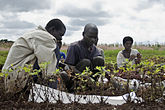Malawian cuisine


Tea and fish are popular features of Malawian cuisine.[1] Sugar, coffee, corn, potatoes, sorghum, cattle and goats are also important components of the cuisine and economy.
Lake Malawi is a source of fish including chambo (similar to bream), usipa (similar to sardine), mpasa (similar to salmon), and kampango.[1]
Nsima is a staple food made from ground corn and served with side dishes of meat, beans and vegetables. It can be eaten for lunch and dinner.[1]
Additional Malawi cuisine includes:
- Kachumbari, a type of tomato and onion salad, known locally in Malawi as a sumu or shum or simply 'tomato and onion salad'.
- Thobwa, a fermented drink made from white maize and millet or sorghum.
- Kondowole, made from cassava flour and water.[2][3] It is primarily from northern Malawi and is a very sticky meal resembling Malawian nsima, Tanzanian ugali, or Ugandan posho. It is mostly cooked on the floor because of its texture as it is normally tough to run a cooking stick through hence much strength is needed. Kondowole is normally eaten with fish.
- Futali
- Nthochi, banana bread
- Location of Malawi
- Harvesting groundnuts at an agricultural research station in Malawi
- Women in Salima District, Malawi, selling groundnuts
- Rice fields in Karonga
- A local Malawian variety of sorghum
Fish
[edit]Fish in Malawi ranges from utaka, kapenta, kampango, bombe, mlamba, micheni, butter fish (known as batala) and chambo (a famous fish from Lake Malawi) among others.[citation needed]
Kondowole is not a meal that can be made in bulk because of its consistency and texture, therefore is not as frequently eaten as nsima.[citation needed]
See also
[edit]References
[edit]- ^ a b c Food Archived 2013-03-14 at the Wayback Machine Malawi Embassy
- ^ The World Cassava Economy: Facts, Trends and Outlook. Food & Agriculture Org. 1 January 2000. pp. 24–. ISBN 978-92-5-104399-8.
- ^ Michael M'tisunge Phoya (2008). Walks of Life: The Other Side of Malawi. IITA. pp. 29–. ISBN 978-99908-941-0-3.


 French
French Deutsch
Deutsch



